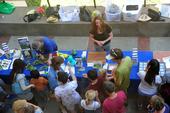- Author: Karey Windbiel-Rojas

Come visit me at the UC Davis Picnic Day event this Saturday April 21, 2018! The UC Statewide IPM Program sets up informational tables every year in the Entomology Department at Briggs Hall.
We will give out ladybugs (lady beetles), have preserved insects on display, showcase our publications and outreach materials, and be there to answer people's pest questions.
Stop by and say hello and check out all the fun activities and information UC IPM and the Entomology Department has to show you!
- Author: Karey Windbiel-Rojas
![Asian citrus psyllid adult and nymphs. [Credit: ME Rogers]](https://ucanr.edu/blogs/CCUrbanPests/blogfiles/50657small.jpg)
Recently I was asked whether the Asian citrus psyllid has been detected in Solano County. Since I wasn't sure, I thought I'd share the news of what I found out. Please see the notice below from the Solano County Agricultural Commissioner from December 2016.
- Author: Karey Windbiel-Rojas
![California burclover. [Credit: Jack Kelly Clark]](https://ucanr.edu/blogs/CCUrbanPests/blogfiles/50079small.jpg)
Weeds can be a real nuisance in gardens and landscapes, and even during the colder winter months, some kinds of weeds continue to grow and thrive. These are called winter annual weeds.
Most weeds are classified as annuals, biennials, or perennials. Annuals complete their life cycle (germinate from seed, grow, flower, set seed, and die) in one year or less, biennials generally complete their life cycle in 2 years, and perennials live longer than 2 years.
Examples of winter annual weeds include chickweed, little mallow, and annual bluegrass. They germinate and actively grow during fall and winter, then produce seed and die by the hot summer months.
If allowed to set seed, annual winter weeds can continue to grow...
- Author: Karey Windbiel-Rojas
![Infestation of young redhumped caterpillars. [Credit: Jack Kelly Clark]](https://ucanr.edu/blogs/CCUrbanPests/blogfiles/50078small.jpg)
The redhumped caterpillar is a familiar pest of fruit and nut trees such as plum, almond, cherry, and apple, as well as ornamental trees like liquidambar and birch. These caterpillars can reach high populations in our area, sometimes defoliating entire branches or entire trees.
The newly revised Pest Notes: Redhumped Caterpillar, authored by Area IPM Advisor Emily Symmes and Steve Dreistadt, UC Statewide IPM Program, describes the pest, its life cycle, and how the insect damages plants. The peer-reviewed publication also describes management techniques, including use of insectary plants, cultural controls, and biological control.
- Author: Karey Windbiel-Rojas
![Dandelion mature plant. [Credit: G and B Corsi]](https://ucanr.edu/blogs/CCUrbanPests/blogfiles/49908small.jpg)
We've had some rain in our area lately so you are probably seeing some weeds starting to grow in your garden or lawn. Among the few new weeds poking out in my landscape is dandelion, my husband's least favorite weed on Earth.
Hopefully you are aware of UC IPM's YouTube video series, but if not, we have a few dozen short videos cover pest topics such as catching a spider, trapping snails and slugs, and how to remove dandelions.
The "How to Remove Dandelions" talks about different nonchemical tools you can use to pull out unwanted weeds and discusses the importance of getting as much of that tap root as possible.

